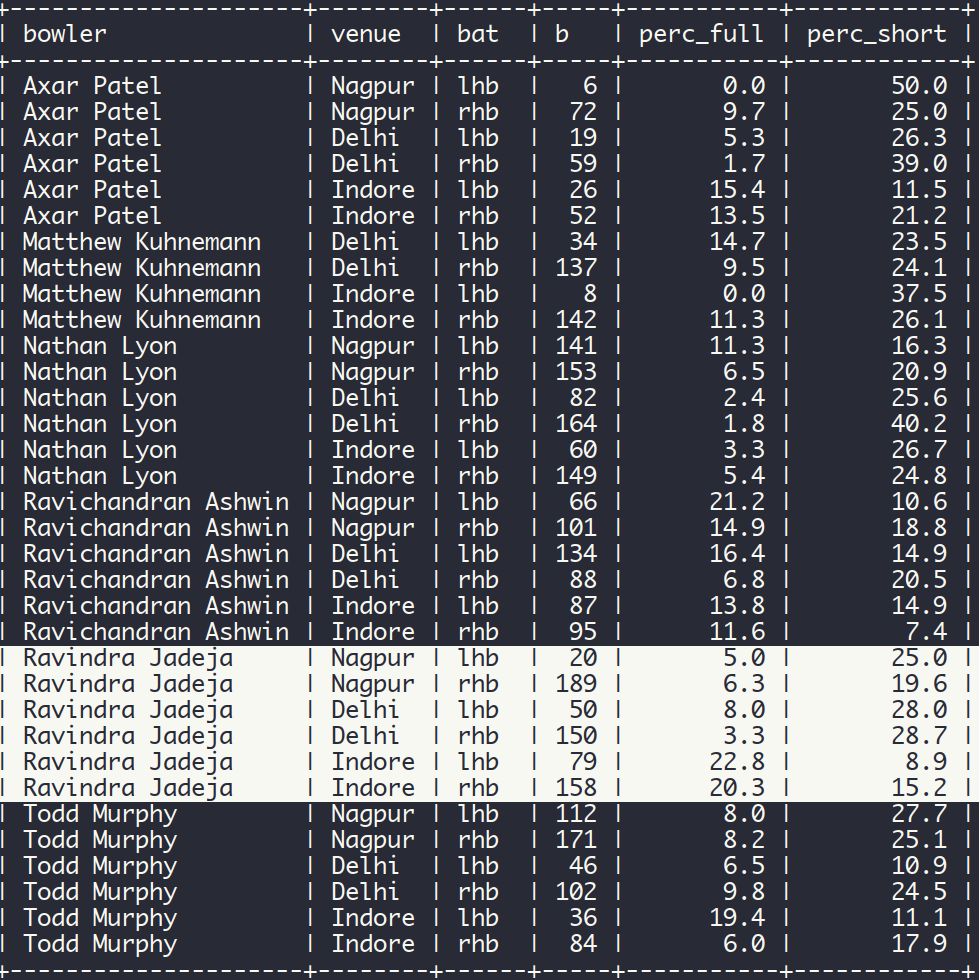Chasing Wickets Instead Of Control
A difference in the way IND bowled at Indore compared to Nagpur and Delhi
The Indore pitch was classed as POOR by the ICC’s Match Referee. The pitches at Nagpur and Delhi were classed as AVERAGE. Given the increased variability in the bounce on the Indore pitch, a fair contest between bat and ball became very difficult. In cricket, lateral deviation - whether it is seam or spin - is considered acceptable, but vertical deviation - variable bounce - is considered unacceptable. The referee noted that the pitch provided “little or no seam movement and there was excessive and uneven bounce throughout the match”.
The BCCI publishes ball-by-ball ball tracking records for home internationals on its website (for eg. here’s the scorecard and ball-by-ball hawkeye record for the Nagpur Test). These are summaries in the three tables below. Only the fingers spinners who featured in these three Tests are considered.



The ICC’s conclusion that the Indore Test offered more uneven bounce than the first two Tests is borne out by the record. Consider the record for the 5m length (Figure 2). At Delhi and Nagpur, 1 in 41 deliveries pitched on this length by the finger spinners reached the stumps either half-way down the stumps or lower. At Indore, 1 in 14 deliveries behaved in this way. At the same time, 1 in 4 deliveries of 5m length at Indore also crossed above stump height. If we consider the same record for the 4m length (you would expect the ball to cross the stumps, on average lower), then not only is he average height the same as the 4m length, but the % of deliveries passing above the stumps from a 4m height is greater than it is from a 5m heighter. This pattern is not repeated in the Delhi and Nagpur cases. This record demonstrates that the bounce in Indore was measurably more unpredictable compared to Delhi and Nagpur.
Even so, did the bowlers bowl differently in Nagpur? The sense one got from watching was that the Indian spinners, and Ravindra Jadeja in particular (see Figure 4), were trying too hard to get wickets, instead of maintaining their usual control. They kept trying magic balls too often, and in the process, overpitched more often.
At Indore, Jadeja overpitched 1 in every 5 balls to the right handers, compared to 1 in every 30 balls to the right hander at Delhi. Note that when the spinner does not overpitch, the batter is prompted to step out, and often, the shortpitched deliveries are a bowler responding to seeing the batter step out. So overpitching too often becomes a problem because the batter is then content to score from the overpitched deliveries and wait for the shortpitched ones too.
At Nagpur, Jadeja conceded 20 runs in 17 overpitched deliveries (he conceded 76 off the bat in 204 legal deliveries in all). At Delhi, he conceded 8 in 13 overpitched deliveries (he conceded 109 in 199 in all, mostly because the Australians decided to counter-attack with sweeps and reverse-sweeps). At Indore, he conceded 37 in 52 overpitched deliveries (he conceded 98 in 234 balls in all).
Ashwin overpitched to the left-handers in the Nagpur Test too. As he explained after the match, Nagpur was a slow wicket on which the bat-pad and he was trying to get the left-handers to drive.
If these figures are published by the BCCI, then the Indian management, with its analysts and proprietary data sources will almost certainly have noticed what is presented in this post. Australia should expect to see an adjustment from Jadeja in the upcoming Ahmedabad Test.
If you notice any other interesting things in the figures posted here, please leave a comment.


